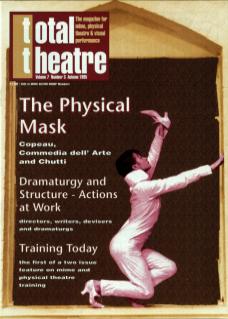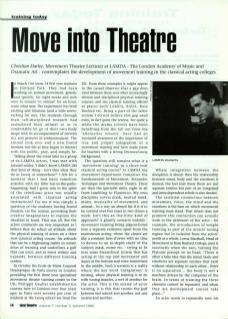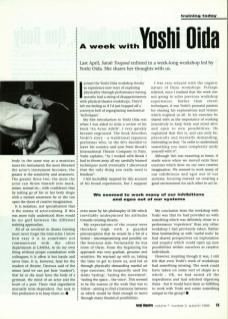In March I let loose fourteen first-year students in Holland Park. They had been working on animal movement, generic and specific, for eight weeks and now were to remain 'in animal' for an hour, come what may. The experiment was both exciting and hilarious (and a little nerve-wracking for me). The students, through their self-disciplined research, had assimilated their animal so as to comfortably let go of their own body shape with its accompaniment of nervous tics and gestures of embarrassment. The animal took over and a new found freedom was felt as they began to interact with the public, play, and simply be.
Talking about the event later to a group of ex-LAMDA actors, I was met with amused smiles: 'I didn't know LAMDA did that kind of thing – isn't that what they do at Lecoq or somewhere?' I felt for a moment that I had been somehow anarchic with my little fun-in-the-parks-happening; had I given rein to the spirit of the rebellious actor not usually associated with classical acting institutions? For me it was simply a question of the students having found freedom via the animal, provoking their creative imaginations to explore the situation in hand. That was all. But the actors’ comments are very important as I believe they do reflect an attitude about the physical training of actors on a three-year classical acting course. An attitude that can be a frightening reality in certain areas of training and underlines a gulf that can exist, and at worst that widens and expands, between different training centres.
In October the Ecole de Mime Corporel Dramatique de Paris moves to London providing the first three-year specialised movement theatre training centre in the UK; Philippe Gaulier established his courses here in London over four years ago; in Paris over seventy per cent of students at the Lecoq school are from the UK. From these examples it might appear to the casual observer that a gap does exist between these and other increasingly diverse and disciplined physical training courses, and the classical training offered at places such LAMDA, RADA, Rose Bruford, etc. Being a part of the latter system I do not believe this gap need exist, in fact quite the reverse. For quite a while the drama schools have been benefiting from the fall out from the 'alternative schools', have had an increased awareness of the importance of true and proper integration of a movement training, and have made room for teachers with a strong Decroux/Lecoq background.
The question still remains what is a 'movement training' in a three-year classical acting course? At LAMDA the movement department comprises the Fundamentals of Movement, Alexander Technique and Movement Theatre. There are then the specialist skills, eight in all from tumbling to Flamenco. My own discipline covers mask, neutral mask, mime, musicality of movement, and animal... In a way an absurd list if it is to be covered over two years in two classes a week. Isn't this an itsy-bitsy kind of approach? A ghastly scenario unfolds – movement training being pigeon-holed into a separate existence apart from the mainstream acting, where the classes are like a constant hors d'oeuvre with no time to devote to an in-depth study of the subject – mask, mime, etc, trying to fit into some hierarchical system that has acting at the top and movement and dance at the bottom and voice somewhere in the middle. Such a scenario is a reality where the key word 'integration' is missing, where physical training is to do with toning muscles, a sort of aerobics for the actor. This is the enemy of actor training, it is this that creates the gulf between one school and another, not one system and another.
Where integration between the disciplines is absent then the relationship between mind, body and the emotions is denied; the fact that these three are not separate entities but part of an integrated and interdependent whole is also denied.
The essential connection between movement, voice, the mind and the emotions is the base on which movement training must stand. That which does not promote this connection can actually work to the detriment of the actor – for example, the introduction of weight training as part of the muscle toning regime but in isolation from the actor’s needs as a whole. Lorna Marshall, Head of Movement at Rose Bruford College, puts it succinctly when she says, turning the Platonic precept on its head, ‘There is often a false idea that the mind, body and emotions are separate entities that exist without relationship to each other... there is no separation... the body is not a machine driven by the computer of the brain. In terms of training the three elements cannot be separated, and when they are development cannot take place...’
An actor needs to repeatedly tune his body in the same way as a musician tunes his instrument; the more liberated the actor's instrument becomes, the greater is the sensitivity and awareness. The greater these two, the more the actor can throw himself into mask, mime, animal, etc, with confidence that by letting go of his or her body shape with a trained awareness he or she can open the doors of creative imagination.
It is isolation, not specialisation that is the enemy of actor-training. If this was more fully understood there would be no gulf between the different training approaches.
All of us involved in drama training must never forget the total actor. I know how easy it is to sometimes not communicate with the other departments at LAMDA, to do my own thing without proper consultation with colleagues; it is often less hassle and saves time. It is, however, fatal for the student of theatre. Decroux said of the mime (and we can put here 'student'), that he or she must have the body of a gymnast, the mind of an actor and the heart of a poet. Three vital ingredients mutually interdependent. Our task in this profession is to keep them so.


